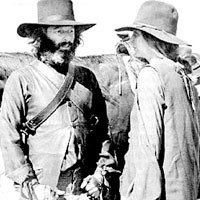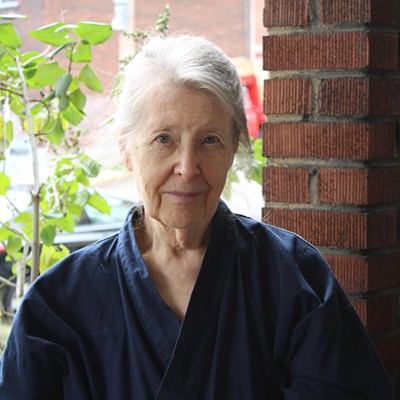A filmmaker who borrows, or just plain steals, the bricks and mortar to construct his vision can prove as original as anyone. That's arguably the case with Alejandro Jodorowsky and his El Topo, a 1970 cult classic that's been unavailable theatrically (or on video) for a quarter-century, but is now screening in a new print.
Born in Chile, Jodorowsky was living in Mexico when he made this wild, strikingly photographed independent production. He begins it by playing with the spaghetti-Westernized iconography of the silently macho rider. Except that the bearded, black-leather-clad gunman (portrayed by Jodorowsky) is on a spiritual quest: After avenging a massacre, and abandoning his young son to some monks, he becomes obsessed with finding and defeating four "gun masters" scattered about the desert.
At minimum, El Topo is an exemplary, lysergically bent period piece. Jodorowsky steals unabashedly from contemporary sexploitation flicks (two women have a bullwhip fight -- and make out!), kung-fu movies, the Old Testament and the Crucifixion ... not to mention Fellini, Freaks and a literally incendiary form of anti-war protest.
The film intrigues by opening with a stark rite of passage in the desert, and a brief fable about its titular animal, a mole that digs through darkness only to be blinded by the sun. Jodorowsky occasionally stuns with a facility for remarkable settings -- desertscapes, stone ruins -- and bits of surreal theater, such as banditos who cavort in tandem, like malevolent circus clowns, and a man with no legs carried like a backpack by a man with no arms.
El Topo grates, too, and not just because of primitive sound effects that, for example, suggest swarming flies with what sounds like a kazoo trio. In the film's first half, most of Jodorowsky's interesting visuals service male fantasies (about men, women, sex, violence and spiritual enlightenment). And El Topo is convulsively, and remorselessly, bloody.
But here's why: In the film's second half, the black-haired cowboy who said "I am God" (while castrating a miscreant) is reborn as an orange-haired accidental idol, worshipped by misbegotten cave-dwellers. Then he's shaved bald and teamed with his dwarf lover in a doomed attempt to unite the incest-raddled subterranean tribe with a dusty, slave-holding frontier town -- which I guess is America, making the cave people the Third World?
El Topo found its U.S. audience in 1971, when it began a semi-legendary run as the first major midnight movie at one New York theater. Though the film can be derivative, self-indulgent and pretentious -- the main sections are titled "Genesis," "Prophets" and "Apocalypse" -- there's real power in Jodorowsky's eccentric vision. The world, after all, is still sick with violence, and the hero's transformation from bad-ass cowboy heretic into a humble-ass monk-clown-husband still resonates. In Spanish, with subtitles. 
Fri., Jan. 26-Feb. 1. Melwood














